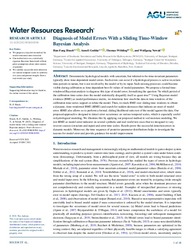Diagnosis of Model Errors With a Sliding Time‐Window Bayesian Analysis
DOI: https://doi.org/10.1029/2021WR030590
Persistent URL: http://resolver.sub.uni-goettingen.de/purl?gldocs-11858/9989
Persistent URL: http://resolver.sub.uni-goettingen.de/purl?gldocs-11858/9989
Supplement: https://doi.org/10.18419/darus-1836
Hsueh, Han‐Fang; Guthke, Anneli; Wöhling, Thomas; Nowak, Wolfgang, 2022: Diagnosis of Model Errors With a Sliding Time‐Window Bayesian Analysis. In: Water Resources Research, Band 58, 2, DOI: 10.1029/2021WR030590.
 |
Dokument öffnen: |
Deterministic hydrological models with uncertain, but inferred‐to‐be‐time‐invariant parameters typically show time‐dependent model errors. Such errors can occur if a hydrological process is active in certain time periods in nature, but is not resolved by the model or by its input. Such missing processes could become visible during calibration as time‐dependent best‐fit values of model parameters. We propose a formal time‐windowed Bayesian analysis to diagnose this type of model error, formalizing the question “In which period of the calibration time‐series does the model statistically disqualify itself as quasi‐true?” Using Bayesian model evidence (BME) as model performance metric, we determine how much the data in time windows of the calibration time‐series support or refute the model. Then, we track BME over sliding time windows to obtain a dynamic, time‐windowed BME (tBME) and search for sudden decreases that indicate an onset of model error. tBME also allows us to perform a formal, sliding likelihood‐ratio test of the model against the data. Our proposed approach is designed to detect error occurrence on various temporal scales, which is especially useful in hydrological modeling. We illustrate this by applying our proposed method to soil moisture modeling. We test tBME as model error indicator on several synthetic and real‐world test cases that we designed to vary in error sources (structure and input) and error time scales. Results prove the successful detection errors in dynamic models. Moreover, the time sequence of posterior parameter distributions helps to investigate the reasons for model error and provide guidance for model improvement. Key Points:
We propose a data‐driven method for model‐structural error detection.
Our method rests on a statistically rigorous Bayesian framework without prior assumptions about error sources or patterns.
We confirm successful error detection on various temporal scales in synthetic test cases and present insights from a real‐world case study.
Statistik:
ZugriffsstatistikSammlung:
This is an open access article under the terms of the Creative Commons Attribution License, which permits use, distribution and reproduction in any medium, provided the original work is properly cited.

